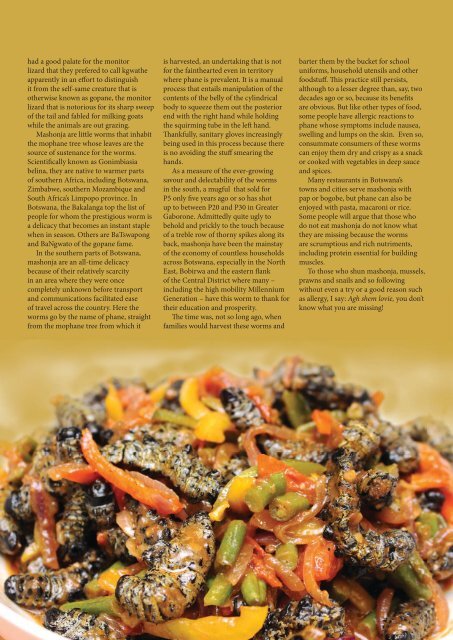inBUSINESS Issue 12
You also want an ePaper? Increase the reach of your titles
YUMPU automatically turns print PDFs into web optimized ePapers that Google loves.
had a good palate for the monitor<br />
lizard that they prefered to call kgwathe<br />
apparently in an effort to distinguish<br />
it from the self-same creature that is<br />
otherwise known as gopane, the monitor<br />
lizard that is notorious for its sharp sweep<br />
of the tail and fabled for milking goats<br />
while the animals are out grazing.<br />
Mashonja are little worms that inhabit<br />
the mophane tree whose leaves are the<br />
source of sustenance for the worms.<br />
Scientifically known as Gonimbiasia<br />
belina, they are native to warmer parts<br />
of southern Africa, including Botswana,<br />
Zimbabwe, southern Mozambique and<br />
South Africa’s Limpopo province. In<br />
Botswana, the Bakalanga top the list of<br />
people for whom the prestigious worm is<br />
a delicacy that becomes an instant staple<br />
when in season. Others are BaTswapong<br />
and BaNgwato of the gopane fame.<br />
In the southern parts of Botswana,<br />
mashonja are an all-time delicacy<br />
because of their relatively scarcity<br />
in an area where they were once<br />
completely unknown before transport<br />
and communications facilitated ease<br />
of travel across the country. Here the<br />
worms go by the name of phane, straight<br />
from the mophane tree from which it<br />
is harvested, an undertaking that is not<br />
for the fainthearted even in territory<br />
where phane is prevalent. It is a manual<br />
process that entails manipulation of the<br />
contents of the belly of the cylindrical<br />
body to squeeze them out the posterior<br />
end with the right hand while holding<br />
the squirming tube in the left hand.<br />
Thankfully, sanitary gloves increasingly<br />
being used in this process because there<br />
is no avoiding the stuff smearing the<br />
hands.<br />
As a measure of the ever-growing<br />
savour and delectability of the worms<br />
in the south, a mugful that sold for<br />
P5 only five years ago or so has shot<br />
up to between P20 and P30 in Greater<br />
Gaborone. Admittedly quite ugly to<br />
behold and prickly to the touch because<br />
of a treble row of thorny spikes along its<br />
back, mashonja have been the mainstay<br />
of the economy of countless households<br />
across Botswana, especially in the North<br />
East, Bobirwa and the eastern flank<br />
of the Central District where many –<br />
including the high mobility Millennium<br />
Generation – have this worm to thank for<br />
their education and prosperity.<br />
The time was, not so long ago, when<br />
families would harvest these worms and<br />
barter them by the bucket for school<br />
uniforms, household utensils and other<br />
foodstuff. This practice still persists,<br />
although to a lesser degree than, say, two<br />
decades ago or so, because its benefits<br />
are obvious. But like other types of food,<br />
some people have allergic reactions to<br />
phane whose symptoms include nausea,<br />
swelling and lumps on the skin. Even so,<br />
consummate consumers of these worms<br />
can enjoy them dry and crispy as a snack<br />
or cooked with vegetables in deep sauce<br />
and spices.<br />
Many restaurants in Botswana’s<br />
towns and cities serve mashonja with<br />
pap or bogobe, but phane can also be<br />
enjoyed with pasta, macaroni or rice.<br />
Some people will argue that those who<br />
do not eat mashonja do not know what<br />
they are missing because the worms<br />
are scrumptious and rich nutriments,<br />
including protein essential for building<br />
muscles.<br />
To those who shun mashonja, mussels,<br />
prawns and snails and so following<br />
without even a try or a good reason such<br />
as allergy, I say: Agh shem lovie, you don’t<br />
know what you are missing!<br />
www.inbusiness.co.bw | <strong>Issue</strong> <strong>12</strong> | 2017 39
















